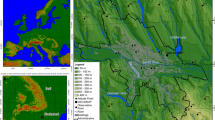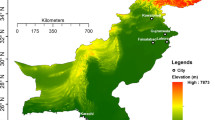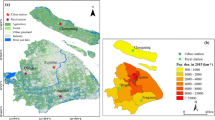Abstract
We analyzed the annual, monthly, and seasonal variations of urban heat island (UHI) intensity in Istanbul by using meteorological data measured for the period of 1960–2012 at six stations. The UHI on minimum temperature is found to be positive for all seasons, and the average UHI intensity clearly indicates seasonal changes, strongest in summer and weakest in winter. The results demonstrated increase of night time UHI intensity with 0.41–0.50 °C/decade and decrease of daytime UHI intensity with 0.13–0.18 °C/decade at the urban sites. The UHI strengthened with the expansion of the city due to increased population. The influences of meteorological variables on seasonality of the UHI intensity are examined for the days categorized depending on wind, cloud cover, and precipitation values. It is found that the UHI intensity decreases with increasing wind speed and cloud cover. The integrated response of the city atmosphere to wind speed changes differ such that daytime UHI in urban atmosphere intensifies rapidly from calm conditions to the wind speeds of 2–3 m/s, then slightly increases until 4–5-m/s wind speeds and starts to decline afterwards. On the other hand, the nighttime UHI intensities in urban sites continuously decline with the same rate until the wind speeds reach to 5–6 m/s. The difference of daytime UHI between rainy summer days and dry days is around 1 °C which is almost independent of the precipitation amount. Both nighttime and daytime UHI intensities depend on the season and site range approximately between 0.24 and 1.74 °C and − 0.62 and 2.61 °C, respectively. However, the UHI based on minimum temperature for the selected dry days with low wind and clear sky conditions increases to 1.70–3.08 °C. Land surface data from Moderate-Resolution Imaging Spectroradiometer (MODIS) Aqua and Terra show areal extension of the UHI through the north along the Bosphorus between 2000 and 2012, especially in the night observations. The continuous increase of built-up areas, paved roads, and decrease of green areas caused the growth of UHI intensity. The estimated UHI based on land surface temperature (LST) at the most urbanized locations of Istanbul reach to 8 °C for daytime and 6 °C for nighttime.









Similar content being viewed by others
References
Arnfield AJ (2003) Two decades of urban climate research: a review of turbulence, exchanges of energy and water, and the urban heat island. Int J Climatol 23:1–26
Azevedo JA, Chapman L, Muller CL (2016) Quantifying the daytime and night-time urban heat island in Birmingham, UK: a comparison of satellite derived land surface temperature and high resolution air temperature observations. Remote Sens 8:153. https://doi.org/10.3390/rs8020153
Barriopedro D, Fischer EM, Luterbacher J, Trigo RM, Garcia-Herrera R (2011) The hot summer of 2010: redrawing the temperature record map of Europe. Science 332:220–224
Chen XL, Zhao HM, Li PX, Yin ZY (2006) Remote sensing image-based of the relationship between urban heat island and land use/cover changes. Remote Sens Environ 104:133–146
Chen Y, Mingy D, Rentao D (2008) Correlation between urban heat island effect and the thermal inertia using aster data in Beijing, China. Int Arch Photogramm Remote Sens Spat Inf Sci XXXVII(Part B7) Beijing 2008
Cui YY, Foy B (2012) Seasonal variations of the urban heat island at the surface and near-surface and reductions due to urban vegetation in Mexico City. J Appl Meteorol Climatol 51:855–868
Dixon PG, Mote TL (2003) Patterns and causes of Atlanta’s urban heat island-initiated precipitation. J Appl Meteorol 42:1273–1284
Eljadid AG (1994) Urban heat island effect in Istanbul City. MSc Thesis, Istanbul Technical University, Institute of Science and Technology
Ezber Y, Sen OL, Kındap T, Karaca M (2007) Climatic effects of urbanization in Istanbul: a statistical and modeling analysis. Int J Climatol 27:667–679
Fischer EM, Oleson KW, Lawrence DM (2012) Contrasting urban and rural heat stress responses to climate change. Geophys Res Lett 39. https://doi.org/10.1029/2011GL050576
Founda D, Pierros F, Petrakis M, Zerefos C (2015) Interdecadal variations and trends of the urban heat island in Athens (Greece) and its response to heat waves. Atmos Res 161:1–13
Gerstengarbe F-W, Werner PC (1999) Estimation of the beginning and end of recurrent events within a climate regime. Clim Res 11:97–107
Giannaros TM, Melas D (2012) Study of the urban heat island in a coastal Mediterranean city: the case study of Thessaloniki, Greece. Atmos Res 118:103–120
Giannaros TM, Melas D, Daglis IA, Keramitsoglou I, Kourtidis K (2013) Numerical study of the urban heat island over Athens (Greece) with the WRF model. Atmos Environ 73:103–111
IBB (2015) Istanbul Greater Istanbul Districts. Retrieved January 15, 2015, from http://www.ibb.gov.tr/tr-tr/kurumsal/pages/ilceveilkkademe.aspx
Jauregui E, Godinez L, Cruz F (1992) Aspects of heat island development in Guadalajara, Mexico. Atmos Environ B Urban Atmos 26:391–396. https://doi.org/10.1016/0957-1272(92)90014-J
Karaca M, Anteplioĝlu Ü, Karsan H (1995a) Detection of urban heat island in Istanbul, Turkey. Il Nuovo Cimento C 18:49–55. https://doi.org/10.1007/BF02561458
Karaca M, Tayanc M, Toros H (1995b) Effects of urbanization on climate of Istanbul and Ankara. Atmos Environ 29:3411–3421
Karaca M, Unal Y, Goksel C (2000) Effects of urbanization on the regional climate: example of Istanbul, ECAC2000 3rd European Conference on Applied Climatology, Pisa, Italy, pp 257–261
Kassomenos PA, Katsoulis BD (2006) Mesoscale and macroscale aspects of the morning urban heat island around Athens, Greece. Meteorog Atmos Phys 94:209–218
Kaya S, Basar UG, Karaca M, Seker DZ (2012) Assessment of urban heat island using remotely sensed data. Ekoloji 21(84):107–113
Kim YH, Baik JJ (2002) Maximum urban heat island intensity in Seoul. J Appl Meteorol 41:651–659
Kim YH, Baik JJ (2004) Daily maximum urban heat island intensity in large cities of Korea. Theor Appl Climatol 79:151–164
Klysik K, Fortuniak K (1999) Temporal and spatial characteristics of the urban heat island of Lodz, Poland. Atmos Environ 33:3885–3895
Kolokotsa D, Diakaki C, Grigoroudis G, Stavrakakis G, Kalaitzakis K (2009) Decision support methodologies on the energy efficiency and energy management in buildings. Adv Build Energy Res 3:121–146
László E, Bottyán Z, Szegedi S (2016) Long-term changes of meteorological conditions of urban heat island development in the region of Debrecen, Hungary. Theor Appl Climatol 124:365–373
Lin CY, Chen WC, Liu SC, Liou YA, Liu GR, Lin GR, Lin TH (2008) Numerical study of the impact of urbanization on the precipitation over Taiwan. Atmos Environ 42:2934–2947
Lowry W (1977) Empirical estimation of urban effects on climate: a problem analysis. J Appl Meteorol 16:129–135
Magee N, Curts J, Wendler G (1999) The urban heat island effect at Fairbanks, Alaska. Theor Appl Climatol 64:39–47
Martin-Vide J, Sarricolea P, Moreno-Garcia MC (2015) On the definition of urban heat island intensity: the “rural” reference. Front Earth Sci 3. https://doi.org/10.3389/feart.2015.00024
Morris CJG, Simmonds I, Plummer N (2001) Quantification of the influences of wind and cloud on the nocturnal urban heat island of a large city. J Appl Meteorol 40:169–182
NASA Land Processes Distributed Active Archive Center (2015) MODIS/Aqua Land Surface Temperature and Emissivity Daily L3 Global 1 km grid. USGS Earth Resources Observation and Science (EROS) Center, Sioux Falls, South Dakota, https://lpdaac.usgs.gov/lpdaac/products/modis_products_table/land_surface_temperature_emissivity/daily_l3_global_1 km/myd11a1. Accessed 22 May 2017
Oke TR (1982) The energetic basis of the urban heat island. Q J R Meteorol Soc 108:1–24
Oke TR (1987) Boundary layer climate, 2nd edn. Routledge, Abingdon
Ozdemir H, Unal A, Kindap T, Turuncoglu U, Durmusoglu ZO, Khan M, Tayanc M, Karaca M (2012) Quantification of the urban heat island under a changing climate over Anatolian Peninsula. Theor Appl Climatol 108:31–38
Pandey AK, Singn S, Berwal S, Kumar D, Pandey P, Prakash A, Lodhi N, Maithani S, Jain VK, Kumar K (2014) Spatio-temporal variations of urban heat island over Delhi. Urban Clim 10:119–133
Philandras CM, Metaxas DA, Nastos PT (1999) Climate variability and urbanization in Athens. Theor Appl Climatol 63:65–72
Rajagopalan P, Lim KC, Jamei E (2014) Urban heat island and wind flow characteristics of a tropical city. Sol Energy 107:159–170
Robine JM, Cheung SLK, LeRoy S, Van Oyen H, Griffiths C, Michel JP, Herrmann FR (2008) Death toll exceeded 70,000 in Europe during the summer of 2003. C R Biol 331:171–178
Roth M, Oke TR, Emery WJ (1989) Satellite-derived urban heat islands from three coastal cities and the utilization of such data in urban climatology. Int J Remote Sens 10:1699–1720
Santamouris M (2014) Cooling the cities – a review of reflective and green roof mitigation technologies to fight heat island and improve comfort in urban environments. Sol Energy 103:682–703
Soltani A, Sharifi E (2017) Daily variation of urban heat island effect and its correlations to urban greenery: a case study of Adelaide. Front Archit Res 6:529–538
Sonali P, Kumar DN (2013) Review of trend detection methods and their application to detect temperature changes in India. J Hydrol 476:212–227
Stewart ID (2011) A systematic and scientific critique of methodology in modern urban heat island literature. Int J Climatol 31:200–217
Stewart ID, Oke TR (2012) Local climate zones for urban temperature studies. Bull Am Meteor Soc 93:1879–1900
Streutker D (2003) Satellite-measured growth of the urban heat island of Houston, Texas. Remote Sens Environ 85:282–289
Sun R, Chen L (2012) How can urban water bodies be designed for climate adaptation? Landsc Urban Plan 105:27–33
Sun CY, Lee KP, Lin TP, Lee SH (2012) Vegetation as a material of roof and city to cool down the temperature. Adv Mater Res 461:552–556
Susca T, Gaffin SR, Dell’Osso GR (2011) Positive effects of vegetation: urban heat island and green roofs. Environ Pollut 159:2119–2126
Theeuwes NE, Solcerova A, Steeneveld GJ (2013) Modeling the influence of open water surfaces on the summertime temperature and thermal comfort in the city. JGR-Atmos 118:8881–8896
Tomlinson CJ, Chapman L, Thornes JE, Baker C (2011) Remote sensing land surface temperature for meteorology and climatology: a review. Meteorol Appl 18:296–306
Tomlinson CJ, Chapman L, Thornes JE, Baker C (2012) Derivation of Birmingham’s summer surface urban heat island from MODIS satellite images. Int J Climatol 32:214–224
TUIK (2015) Turkish Statistical Institute. http://www.tuik.gov.tr. Accessed 16 Apr 2018
Unal YS, Deniz A, Toros H, Incecik S (2012) Temporal and spatial patterns of precipitation variability for annual, wet and dry periods in Turkey. Int J Climatol 32:392–405
Unal YS, Incecik S, Topcu HS, Mentes S, Guney C, Dogru AO, Yuruk C, Diren DH, Bigen SI, Temizoz HP (2018) Local climate change in 3 cities (Cairo, Nairobi, Istanbul) with different population, urban structure, land use classification and climate characteristics and compare different adaptation strategies to local climate change in these cities, TUBITAK, 1001-ERANET ERAfrica 114Y047 project report, p 180, (in Turkish)
Unger J, Sümeghy Z, Gulyas A, Bottanyan Z, Mucsi L (2001) Land-use and meteorological aspects of the urban heat island. Meteorol Appl 8:189–194
United Nations (2015) The 2015 Revision of World Population Prospects. Population Division of the United Nations Department of Economic and Social Affairs.
Vardoulakis E, Karamanis D, Fotiadi A, Mihalakakou G (2013) The urban heat island effect in a small Mediterranean city of high summer temperatures and cooling energy demands. Sol Energy 94:128–144
Voogt JA, Oke TR (2003) Thermal remote sensing of urban climates. Remote Sens Environ 86:370–384
Wang J, Feng J, Yan Z (2015) Potential sensitivity of warm season precipitation to urbanization extents: modeling study in Beijing-Tianjin-Hebei urban agglomeration in China. J Geophys Res Atmos 120:9408–9425
WMO (2010) Guide to meteorological instruments and methods of observation. WMO-Mo 8, Genova
Yague C, Zurita E, Martinez A (1991) Statistical analysis of the urban heat island. Atmos Environ 25B:327–332
Yang Y, Tian F (2009) Abrupt change of runoff and its major driving factors in Haihe River Catchment, China. J Hydrol 374:373–383
Zhou W, Xiaoma YQ, Weifeng L, Han LL (2014) Relationships between land cover and the surface urban heat island: seasonal variability and effects of spatial and thematic resolution of land cover data on predicting land surface temperatures. Landsc Ecol 29:153–167
Acknowledgments
The authors are gratefully acknowledging the State Meteorological Service of Turkey, for providing the meteorological data. We also would like to thank to the reviewers for their valuable comments on the paper.
Funding
This work was funded by TUBITAK project number 114Y047 and ERAfrica LOCLIM3.
Author information
Authors and Affiliations
Corresponding author
Additional information
Publisher’s note
Springer Nature remains neutral with regard to jurisdictional claims in published maps and institutional affiliations.
Electronic supplementary material
Supplement Fig. 1
Distribution of the Summer daytime land surface temperatures from MODIS Earth Observing Satellites for the periods: a) 2000-2002, 2005-2007, 2010-2012 for Terra and b) 2003-2005, 2005-2007, 2010-2012 for Aqua. (PDF 925 kb)
Supplement Fig. 2
Distribution of the summer daytime (upper panel) and nighttime (lower panel) UHI intensity of land surface temperatures averaged for the period of 2003-2012 from MODIS Earth Observing Satellites a) Terra and b) Aqua (PDF 849 kb)
Rights and permissions
About this article
Cite this article
Ünal, Y.S., Sonuç, C.Y., Incecik, S. et al. Investigating urban heat island intensity in Istanbul. Theor Appl Climatol 139, 175–190 (2020). https://doi.org/10.1007/s00704-019-02953-2
Received:
Accepted:
Published:
Issue Date:
DOI: https://doi.org/10.1007/s00704-019-02953-2




